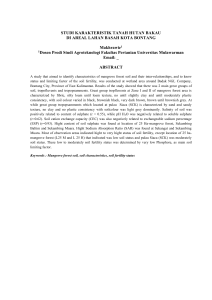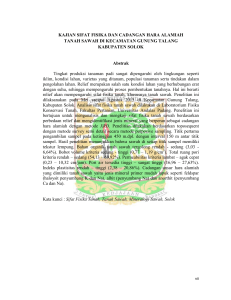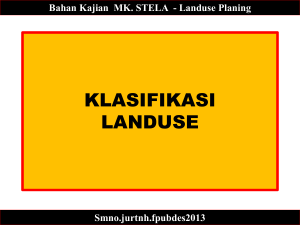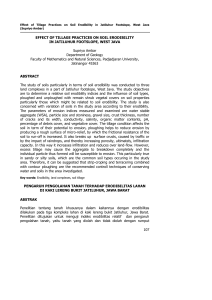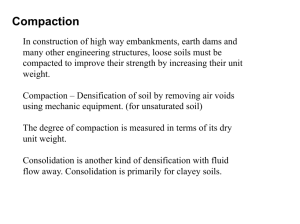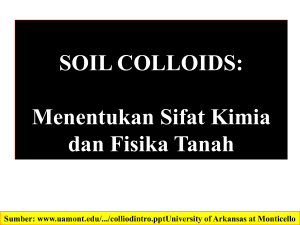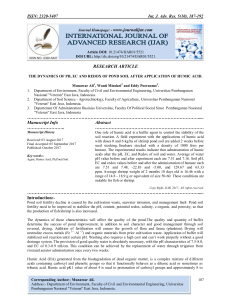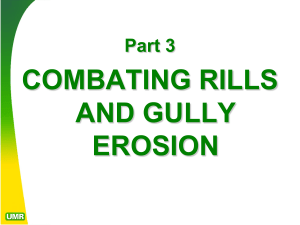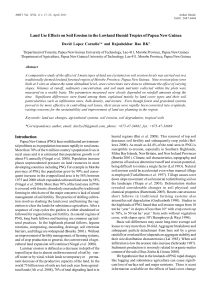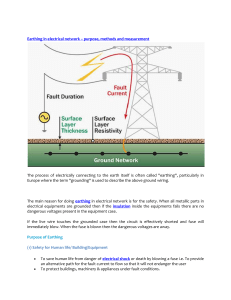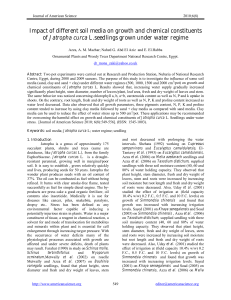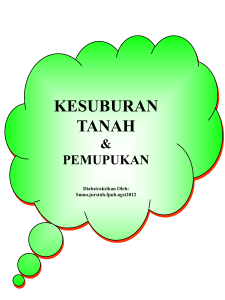Comparation between Soil Performance Indicator and Lettuce
advertisement
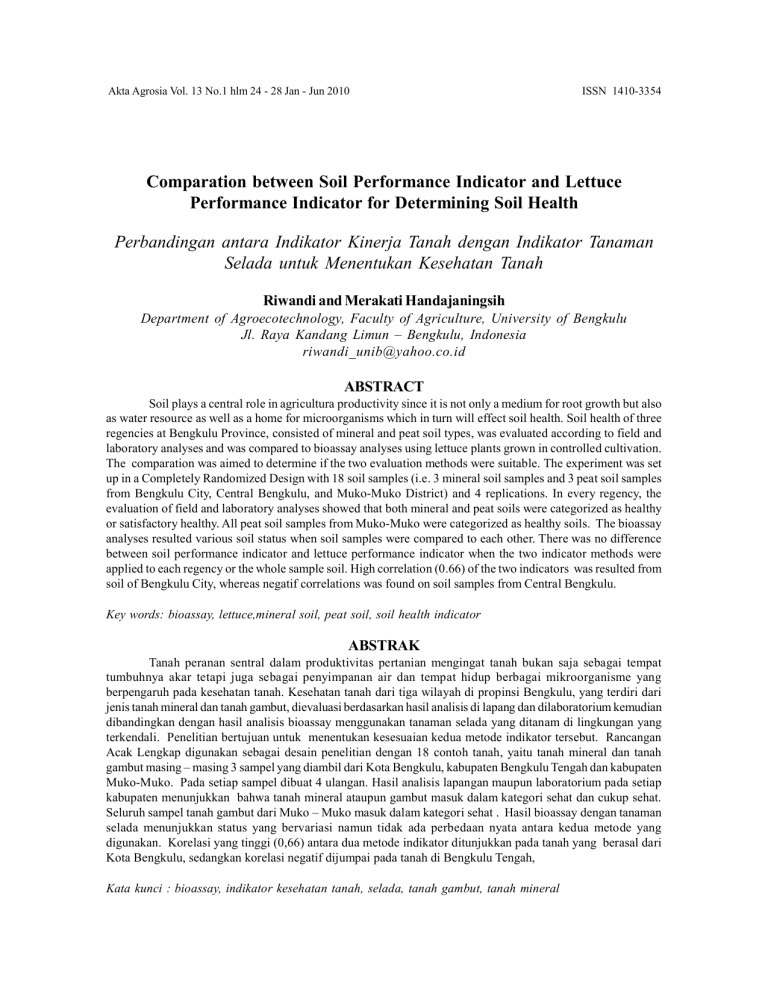
Akta Agrosia Vol. 13 No.1 hlm 24 - 28 Jan - Jun 2010 ISSN 1410-3354 Comparation between Soil Performance Indicator and Lettuce Performance Indicator for Determining Soil Health Perbandingan antara Indikator Kinerja Tanah dengan Indikator Tanaman Selada untuk Menentukan Kesehatan Tanah Riwandi and Merakati Handajaningsih Department of Agroecotechnology, Faculty of Agriculture, University of Bengkulu Jl. Raya Kandang Limun – Bengkulu, Indonesia [email protected] ABSTRACT Soil plays a central role in agricultura productivity since it is not only a medium for root growth but also as water resource as well as a home for microorganisms which in turn will effect soil health. Soil health of three regencies at Bengkulu Province, consisted of mineral and peat soil types, was evaluated according to field and laboratory analyses and was compared to bioassay analyses using lettuce plants grown in controlled cultivation. The comparation was aimed to determine if the two evaluation methods were suitable. The experiment was set up in a Completely Randomized Design with 18 soil samples (i.e. 3 mineral soil samples and 3 peat soil samples from Bengkulu City, Central Bengkulu, and Muko-Muko District) and 4 replications. In every regency, the evaluation of field and laboratory analyses showed that both mineral and peat soils were categorized as healthy or satisfactory healthy. All peat soil samples from Muko-Muko were categorized as healthy soils. The bioassay analyses resulted various soil status when soil samples were compared to each other. There was no difference between soil performance indicator and lettuce performance indicator when the two indicator methods were applied to each regency or the whole sample soil. High correlation (0.66) of the two indicators was resulted from soil of Bengkulu City, whereas negatif correlations was found on soil samples from Central Bengkulu. Key words: bioassay, lettuce,mineral soil, peat soil, soil health indicator ABSTRAK Tanah peranan sentral dalam produktivitas pertanian mengingat tanah bukan saja sebagai tempat tumbuhnya akar tetapi juga sebagai penyimpanan air dan tempat hidup berbagai mikroorganisme yang berpengaruh pada kesehatan tanah. Kesehatan tanah dari tiga wilayah di propinsi Bengkulu, yang terdiri dari jenis tanah mineral dan tanah gambut, dievaluasi berdasarkan hasil analisis di lapang dan dilaboratorium kemudian dibandingkan dengan hasil analisis bioassay menggunakan tanaman selada yang ditanam di lingkungan yang terkendali. Penelitian bertujuan untuk menentukan kesesuaian kedua metode indikator tersebut. Rancangan Acak Lengkap digunakan sebagai desain penelitian dengan 18 contoh tanah, yaitu tanah mineral dan tanah gambut masing – masing 3 sampel yang diambil dari Kota Bengkulu, kabupaten Bengkulu Tengah dan kabupaten Muko-Muko. Pada setiap sampel dibuat 4 ulangan. Hasil analisis lapangan maupun laboratorium pada setiap kabupaten menunjukkan bahwa tanah mineral ataupun gambut masuk dalam kategori sehat dan cukup sehat. Seluruh sampel tanah gambut dari Muko – Muko masuk dalam kategori sehat . Hasil bioassay dengan tanaman selada menunjukkan status yang bervariasi namun tidak ada perbedaan nyata antara kedua metode yang digunakan. Korelasi yang tinggi (0,66) antara dua metode indikator ditunjukkan pada tanah yang berasal dari Kota Bengkulu, sedangkan korelasi negatif dijumpai pada tanah di Bengkulu Tengah, Kata kunci : bioassay, indikator kesehatan tanah, selada, tanah gambut, tanah mineral Riwandi and Merakati Handajaningsih : Comparation between soil performance indicator INTRODUCTION Soil has a very strategic function as a major medium for agriculture and woody plant production, as a controller of water absorption and quality, recycle mineral elements and organic materials, and as a filter of potentially pollutant substances (Idowu et al., 2010a,b). It also has its centered role as a medium for root growth and storage for water, as a home for microorganisms, earthworms, and various insects which have important effects on soil characteristics. The characteristics of soil in turn will effect the plant quality. Table 1. Scoring criteria for lettuce performance indicator Indicator of Plant Components Scoring Plant Height 0-6 cm = 1 7-12 cm = 2 13-18 cm = 3 19-24 cm = 4 25-30 cm = 5 Degree of leaf greenness *) 0-8 = 1 9-16 = 2 17-24 = 3 25-32 = 4 33-40 = 5 Shoot : Root Ratio (% relative) 0-20% = 1 21-40% = 2 41-60% = 3 61-80% =4 81-100% =5 Number of leaves 0-2 = 1 3-4 = 2 5-6 = 3 7-8 = 4> 8=5 Fresh weight 0-20 g = 1 21-40 g =2 41-60 g = 3 61-80 g = 4> 80 g = 5 *) measured by SPAD meter Soil fertility is defined as the capability of soil to provide nutrition elements in a quantity sufficient for plant to grow and to complete its life cycle. Soil health is a combination of optimum soil properties (physical, chemical, and biology) to increase quality and productivity of soil, plant, and environment. The plant status then could be an 25 indicator of soil health since plants will behave in correspond to soil condition. The response to soil status is expressed on its growth and yield. It is commonly known that soil laboratory analysis involves intricate procedures, time consuming, and needs high-skill labor. In contrast, bioassay indicator implemented easier and even the soil status can be interpreted while the plants are still on the field. Lipton (1995) mentioned four plants commonly used in bioassay experiments; they are corn, lettuce, tomato and sunflower. In this research, lettuce was used as soil health indicator. Lettuce has a short harvest time which would be more efficient if this plant is used as soil health indicator. The responses of lettuce to nutrient uptake and the partitioning on plant part had been reviewed in some experiments such as the increasing of N P K uptake in accordance with increasing level of N (Ekonomakis and Koleilat, 2009), remobilizing of N, P, K to the head part as a dominant sink (Huett and Detmann, 1992), and the increasing of Ca content in high temperature (Neeser et al., 2007). The objectives of this experiment were (1). to evaluate the growth and yield of lettuce grown on different soil health, (2) to evaluate if there was a suitability between soil status based on visual and laboratory analyses and soil status based on plant growth and yield parameters, and to evaluate the correlation between soil performance indicator and bioassay indicator using lettuce plant. MATERIALS AND METHODS Soil samples were taken from three different regency areas in Bengkulu Province each of which consisted of three peat soil samples and three mineral soil samples to give a total of 18 samples. The visual and laboratory procedures were determined for standard soil analyses (Bierman, 2007; Balittanah, 2005). Bioassay experiments were arranged in Completely Randomized Design with single factor i.e. 18 soil accessions and 4 replications. Lettuce (bioassay) experiment was carried out under plastic house from June to August 2009. Soil Akta Agrosia Vol. 13 No.1 hlm 24 - 28 Jan - Jun 2010 samples were air-dried and were put into polybags (35 cm x 40 cm) and then arranged under plastic house. A bowl was placed under each polybag to catch excessive water from irrigation. This would assure that no element nutrition leached out of the media. Two seeds of lettuce were planted in each polybag, selected and left into 1 plant 7 days after planting. No fertilizer was applied. Plants were watered in the morning and in the late afternoon. The excessive water in the bowl (if any) was poured back into the media. Seeds were spread on plastic box filled with sand and 26 manure (1:1 v/v) and were transplanted after 21 days. Data from field were collected at harvest time, that was 45 days after transplanting. The plants then were dried in the Lindenberg oven at 60 0C. The scoring was carried out according to the standard determined previously (Table 1). Plant height was the primary lettuce plant indcator, followed by leaf greenness, shoot : root ratio and plant fresh weight. Total score which was presented in percentage was the sum of scoring value of each indicator. Table 2. Soil health status based on soil performance from three areas in Bengkulu Province Note : *) total score = sum of soil performance indicators on the field and laboratory analyses. Soil performance indicators on the field are Soil Color, Soil Moisture Content, Slope, Texture, Peat Maturity, Soil structure, Organic Matter, pH (H20), Earthworm Population, LCC, Soil Erosion, Soil Compaction, and Vegetation Performance. Soil performance indicators on laboratory analyses are C (%), N (%), P2O5 Bray (ppm P), KTK (cmol(+) kg-1), Ca (cmol(+) kg-1), Mg(cmol(+) kg-1), K(cmol(+) kg-1), Bases saturation (%), Al saturation (%), and DHL(dS/m). Table 3. The status of soil health based on bioassay indicators of lettuce plants grown on soil samples from Bengkulu City Riwandi and Merakati Handajaningsih : Comparation between soil performance indicator 27 Tabel 4. The status of soil health based on bioassay indicators of lettuce plants grown on soil samples from Central Bengkulu Table 5. The status of soil health based on bioassay indicators of lettuce plants grown on soil samples from Muko-Muko Table 6. The T-test and correlation values of soil health between soil performance indicator and bioassay indicator of lettuce plant Paired- comparison Standard error T value df Probability (P) Correlation (r) 1A vs 1B 3.02 -1.38 5 0.28 0.66 2A vs 2B 4.25 -1.29 5 0.25 -0.12 3A vs 3B 6.97 -0.41 5 0.70 0.10 ATA1 vs ATA2 2.74 -1.48 17 0.16 0.17 Note : 1A = soil performance indicator of sample soil from Bengkulu City; 2A = soil performance indicator of sample soil from Central Bengkulu; 3A = soil performance indicator of sample soil from Muko-Muko; 1B = bioassay indicator of lettuce grown on soil sample from Bengkulu City; 2B = bioassay indicator of lettuce grown on soil sample from Central Bengkulu; 3B = bioassay indicator of lettuce grown on soil sample from Muko-Muko; ATA1 = soil performance indicator of sample soil from Bengkulu City, Central Bengkulu , and Muko- Muko; ATA2 = bioassay indicator of lettuce grown on soil sample from Bengkulu City, Central Bengkulu, and Muko-Muko Data collected from the experiment was analyzed using T-test to determine the suitability indicator between lettuce and soil indicator. Test of correlation was also completed to show the general correlation between soil and bioassay indicators in each regency area. RESULTS AND DISCUSSION The experiment demonstrated that the status of the 18 soil samples could be classified as healthy and satisfy soils both in mineral and peat soils. Exception was found on peat sample soils from Sumber Makmur, Muko-Muko in which they are all categorized as healthy (Table 2). The analyses of lettuce bioassay showed that the soil health, expressed on growth and yield of lettuce, was categorized as healthy, satisfactory healthy, and unhealthy (Table 3, 4, and 5). Unhealthy soil was found in sample SM6 from MukoMuko in which based on soil performance indicator it was classified as satisfactory healthy. The plants grown on this soil showed stunted growth both shoot and root with yellow leaves indicating that nutrient uptake was impeded. Additional analyses should be taken to revealed this fenomena. Even though the result between soil Akta Agrosia Vol. 13 No.1 hlm 24 - 28 Jan - Jun 2010 laboratory indicator and lettuce indicator was not consistent when comparation made on the same soil sample, the T-Test (Table 6) proved no significantly different between the two soil health indicators. This means that lettuce can be used as bioassay indicator to evaluate soil health in wide soil area. Highest correlation between the two indicator methods was shown on soil from Bengkulu City compared to that of Central Bengkulu and Muko – Muko. This is due to the fact that soil of Bengkulu City covers the fertility properties, such as granule structure, pH 5.0 – 6.0, and moderate soil moisture, which are suitable for the growth of lettuce plants. Moreover, aluminium concentration was found lower than the other soil samples. Low negative correlation was found on soil from Central Bengkulu. CONCLUSION The indicator of soil performance was suitable with plant bioassay indicator. High correlation was only applied between Soil Indicator and Bioassay Indicator for soil of Bengkulu City. Soil health status of three different areas in Bengkulu was categorized as healthy and satisfactory healthy. All peat soil samples of Muko - Muko , North Bengkulu were categorized as healthy soil. REFERENCES Balittanah, 2005. Petunjuk analisis tanah, air, pupuk, dan tanaman. Penelitian dan Pengembangan Tanah dan Agroklimat, Bogor. Bierman, P. 2007. Ohio soil health card. Centers at Piketon, Ohio State Univ. http:// www.ag.ohio-state.edu/-pre. 29 August 2010. Ekonomakis, C. D. and R. Koleilat. 2009. Effect of nitrogen concentration on growth, water, 28 and nutrient uptake of lettuce plants in solution culture. HortSci 38( ): 222 – 227. http://www.actahort.org/ members/ showpdf. 29 August 2010. Gugino, B.K., O.J. Idowu, R.R. Schindelbeck, , van Es, H.M., D.W.Wolfe, , J.E. Thies, and G. S. Abawi,. 2007. Cornell Soil Health Assessment Training Manual, Edition 1.2., Cornell University, N.Y. Huett, D.O. and E.B. Dettmann. 1992. Nutrient uptake and partitioning by zucchini squash, head lettuce and potato in response to nitrogen. Australian J. Agric. Res. 43(7): 1653 – 1665. Idowu, O.J., H. van Es, R.R. Schindelbeck, G. Abawi, D. Wolfe, J. Thies, B. Gugino, B. Moebius, and D. Clune. 2010a. Soil Health Assessment and Management: The Concepts. A Newsletter for New York Field Crops & Soils. Volume 16, Number 2, Mar-Apr, 2006. www.nnyagdev.org/ PDF/SOILHEALTHFSPart2.pdf 29 November 2010. Idowu, J., B. Moebius, H. van Es, R.R. Schindelbeck, G. Abawi, D. Wolfe, J. Thies, B. Gugino, and D. Clune. 2010b. Soil Health Assessment and Management: Measurements and Results. www.nny agdev.org/PDF/SOILHEALT HFSPart2. pdf Download November, 29, 2010. Liptan. 1995. Pendugaan kesuburan tanah dengan cara yenny pot Test. Lembar Informasi Pertanian BIP Irian Jaya. No 149/95. Neeser, C., N. Savidov, and D. Driedger. 2007. Production of hydroponically grown calcium fortified Lettuce. Acta Hort. 774.: International Symposium on Human Health Effects of Fruits and Vegetables. http://www.actahort.org/ members/ showpdf. 29 August 2010. Tisdale, S.T. and W.L. Nelson. 1966 . Soil Fertility and Fertilizer. Mac Millan, New York.
